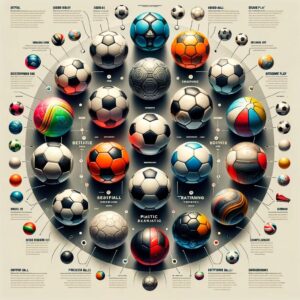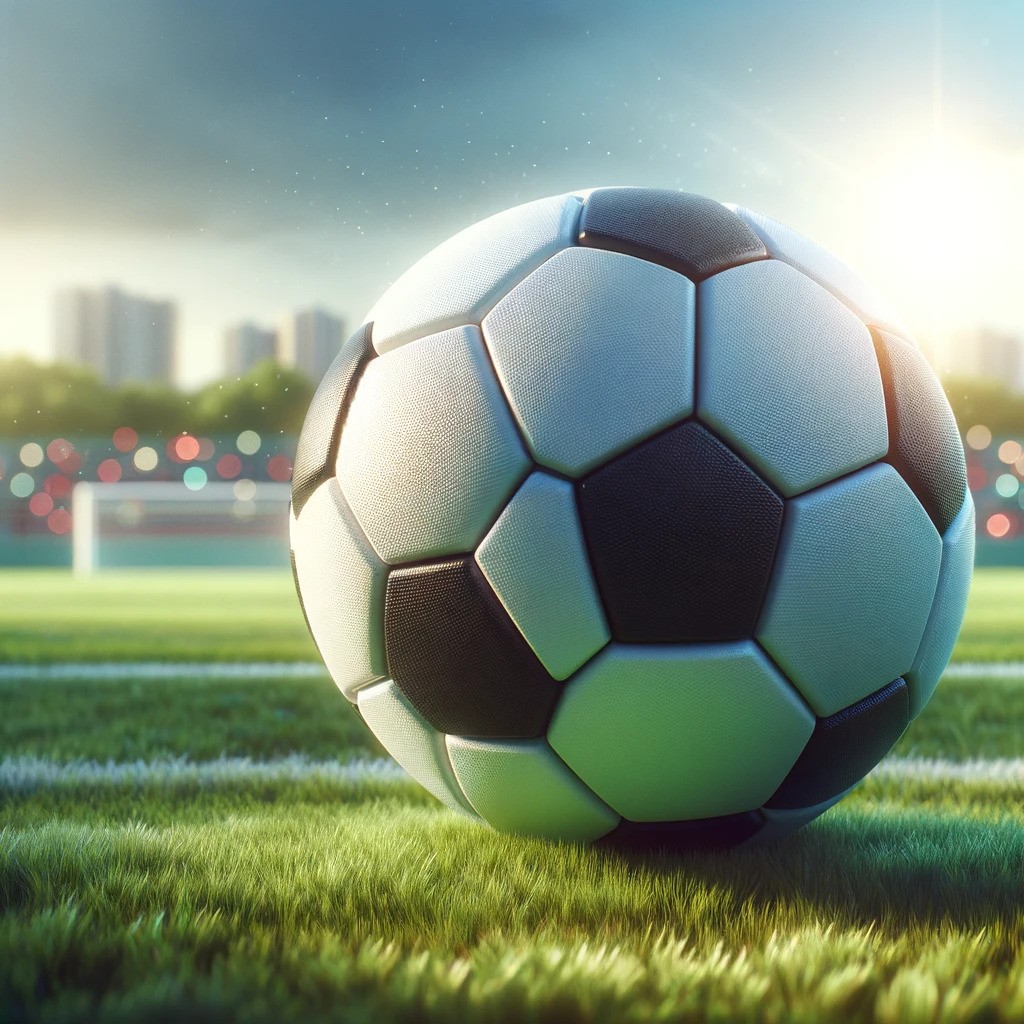In an era where sports technology advances at a rapid pace, the evolution of soccer equipment has kept pace, with particular attention to the soccer ball itself. Traditionally made from leather and other natural materials, the soccer ball has undergone a transformation to include plastic or synthetic versions.
Plastic soccer balls have become a staple on fields across the globe, from schoolyards to professional training facilities. This transition is largely due to their numerous advantages, including enhanced durability, cost-effectiveness, and user safety.
The inception of plastic soccer balls marked a significant shift in how the game is played and practiced. These balls are crafted from various types of plastics and synthetics, each selected for its ability to endure, perform, and mimic the feel of traditional soccer balls under a variety of conditions. Their construction is a testament to the ingenuity of sports engineers, aiming to create a ball that can withstand the rigors of play while being accessible to a broad audience.
Benefits of Plastic Soccer Balls
Durability
One of the standout features of plastic soccer balls is their durability. Traditional leather balls are susceptible to wear and tear, especially when used in harsh weather conditions or on abrasive surfaces. Plastic soccer balls, however, are designed to resist these elements, maintaining their shape and functionality over time.
Their resilience is particularly beneficial in environments where they are used frequently and in various playing conditions, from the rain-soaked fields of spring leagues to the sun-baked grounds of summer camps.
Affordability
Another significant advantage of plastic soccer balls is their affordability. The cost of sports equipment can be prohibitive for many, potentially limiting access to sports for some individuals and communities. Plastic soccer balls offer a more budget-friendly alternative, making them an attractive option for schools, clubs, and casual players.
The lower price point does not necessarily mean lower quality; many plastic soccer balls are designed to meet or exceed the performance of their more expensive counterparts, providing a cost-effective solution without compromising the game.
Safety
Safety is a paramount concern in youth sports, and plastic soccer balls address this concern head-on. These balls tend to be lighter and softer than traditional leather balls, which can help reduce the risk of injuries, such as bruises or concussions, during play. This makes plastic soccer balls especially suitable for younger players who are still learning the game and developing their skills. The reduced weight and softer impact of plastic soccer balls can also improve player confidence, encouraging more active and enthusiastic participation.
Types of Plastic Soccer Balls

Indoor Plastic Soccer Balls
Tailored for indoor use, these balls are designed with a softer exterior to minimize damage to indoor facilities and reduce noise. Their construction allows for controlled bounce and speed, making them ideal for gyms, sports halls, and other indoor arenas where traditional balls might be too hard or unpredictable.
Outdoor Plastic Soccer Balls
Constructed to endure the challenges of outdoor play, these balls are made with a tougher exterior. They are designed to perform optimally on natural grass, artificial turf, and even rough surfaces like concrete. The versatility of outdoor plastic soccer balls ensures that they can be used in a variety of playing conditions without significant wear and tear.
Specialized Plastic Soccer Balls for Training
Training balls often come with unique features to aid in player development. For instance, some have irregular surfaces to challenge players’ control and touch, while others are lighter or heavier than standard balls to help improve strength and technique. These specialized balls are invaluable tools for coaches and players alike, offering targeted ways to enhance skills and performance.
Choosing the Right Plastic Soccer Ball
Choosing the right plastic soccer ball is crucial for both enjoyment and performance in the game. Whether you’re a casual player, a parent looking for a ball for your child, or a coach equipping a team, several factors should guide your decision. Here, we dive deeper into the considerations to ensure you pick the best plastic soccer ball for your needs.
Factors to Consider
- Size
The size of the soccer ball is fundamental to the player’s experience. Soccer balls are categorized into sizes 1 through 5, with each size serving a different age group and skill level. Size 3 balls are typically for children under 8 years, size 4 for players between 8 and 12 years, and size 5 is the standard size for players aged 13 and above, including adults.
Choosing the correct size is essential for proper skill development; a ball that’s too large or too small can hinder a player’s ability to practice dribbling, passing, and shooting effectively.
- Material
While all plastic soccer balls share a common material, the type and quality of plastic can vary significantly. Some balls are made from hard plastics for durability, while others use softer, more flexible plastics for a better feel and control. High-quality balls might also incorporate materials like TPU (thermoplastic polyurethane) or PVC (polyvinyl chloride) in their construction, offering a good balance between durability, performance, and affordability.
The choice of material affects the ball’s weight, feel, and how it behaves on different surfaces, so consider what will best suit your playing conditions.
- Intended Use
The intended use of the soccer ball plays a pivotal role in your selection process. For casual play in the backyard, a basic model may suffice. However, for competitive play or training, you might opt for a ball that meets official size and weight specifications.
Balls designed for training may have additional features to aid in skill development, such as a textured surface for better grip and control or a lighter weight to improve footwork and speed. Consider where and how often the ball will be used to ensure it meets your requirements for durability and performance.
Maintenance and Care
To maximize the lifespan of a plastic soccer ball, proper maintenance and care are essential. Regular maintenance not only keeps the ball in good condition but also ensures it performs well during play.
- Cleaning and Storage
Regular cleaning is crucial for maintaining a plastic soccer ball’s condition. Dirt and grime can accumulate on the ball’s surface, potentially affecting its texture and the way it moves. Use a soft cloth, mild soap, and water to clean the ball, avoiding abrasive materials that could damage its surface.
After cleaning, dry the ball thoroughly before storing it to prevent mold and mildew growth. Proper storage is also important; keep the ball in a cool, dry place out of direct sunlight. Exposure to extreme temperatures and sunlight can degrade the plastic over time, leading to cracks and loss of shape.
- Avoiding Damage
While plastic soccer balls are designed for durability, they’re not immune to damage. To prolong the life of your ball, avoid sitting on it or using it for purposes other than soccer. Excessive weight or improper use can deform the ball, affecting its roundness and how it rolls or flies. Also, be mindful of the surfaces you play on. Rough surfaces like asphalt can wear down the ball’s surface more quickly than grass or turf. By taking these precautions, you can help ensure your plastic soccer ball remains in good condition for as long as possible.
- Environmental Impact
The environmental impact of plastic soccer balls is a growing concern. As awareness of plastic pollution increases, consumers and manufacturers alike are looking for ways to reduce the environmental footprint of sports equipment.
- Recycling and Sustainability
Choosing soccer balls made from recycled materials is one way to mitigate environmental impact. Some manufacturers are now using recycled plastics in their products, which helps to reduce waste and conserve resources. Additionally, investing in a high-quality ball that’s built to last can minimize the need for frequent replacements, thereby reducing overall consumption.
- Reducing Plastic Waste
Consumers can also play a role in reducing plastic waste by supporting brands that are committed to sustainable practices. This includes companies that use eco-friendly materials, employ sustainable manufacturing processes, and offer recycling programs for their products. By making informed choices, players and fans can enjoy the game while also contributing to a healthier planet.
Conclusion
Plastic soccer balls represent a versatile and accessible option for players of all ages and skill levels. By understanding the types available, how to choose the right one, and best practices for care, players can enjoy the beautiful game without compromise. As we move towards a more sustainable future, considering the environmental impact of our sports equipment is also crucial.
Frequently Asked Questions
What is a PVC soccer ball?
A PVC (Polyvinyl Chloride) soccer ball is a type of plastic soccer ball made from a durable, synthetic material. PVC balls are known for their affordability and resistance to wear and tear, making them a popular choice for recreational play and practice. They typically offer a harder surface compared to other materials, which can influence the ball’s feel and control.
What is a PU soccer ball?
A PU (Polyurethane) soccer ball is made from a synthetic leather material that is softer and more responsive than PVC. PU soccer balls are often used in professional and competitive settings due to their superior touch, feel, and durability. These balls generally offer better control and are considered higher quality, making them more expensive than PVC soccer balls.
What is a kinetic soccer ball?
A kinetic soccer ball is designed to enhance player training through the use of integrated technology that measures and provides feedback on the ball’s movement and the player’s interaction with it. These balls can track speed, spin, trajectory, and more, helping players improve their skills with precise, real-time data. Kinetic soccer balls merge traditional soccer equipment with modern technology to elevate training sessions.
Are there microchips in soccer balls?
Yes, some advanced soccer balls have microchips embedded in them. These chips are part of smart ball technology that enables tracking of the ball’s position, speed, and trajectory during play. This technology is used in training tools and, increasingly, in professional matches to enhance performance analysis and audience engagement.
Are NFL footballs chipped?
Yes, NFL footballs have been chipped as part of the league’s ongoing efforts to enhance game statistics and improve viewer experience. These chips collect data on the ball’s location and movement, which can be used for in-depth analysis during games and for coaching purposes.
Do FIFA footballs have chips in them?
Yes, FIFA has introduced footballs with embedded chips in professional competitions. This technology is used to assist with goal-line technology systems and to provide detailed analytics on the ball’s movement during matches, enhancing both officiating accuracy and fan engagement.
Is PVC better than ru bber football?
Whether PVC is better than rubber for footballs depends on the intended use and personal preference. PVC footballs are durable and suitable for play on various surfaces, offering a consistent performance. Rubber footballs, on the other hand, tend to provide better grip and are often used for informal games and training, especially in wet conditions. PVC balls might be preferred for their longevity and resistance to abrasion, while rubber balls offer a softer touch and better control.

